You may have heard about the Tree of Life, Olympic National Park. This famous Washington tree, also called the Kalaloch Tree or the Runaway Tree is one of the highlights of Olympic National Park.
What is, where is it and why should you see it (now)?
Let’s find out.
If you’re planning to visit Olympic National Park by yourself, make your planning easy and stress free with a detailed itinerary. I have 1-, 2-, 3- and 4-day itineraries for Olympic National Park that include all the park highlights, give you choices based on your preferred activity level, and take all the stress out of planning your trip.
No time right now to read about the Tree of Life, Washington State? Pin It and save it for later:

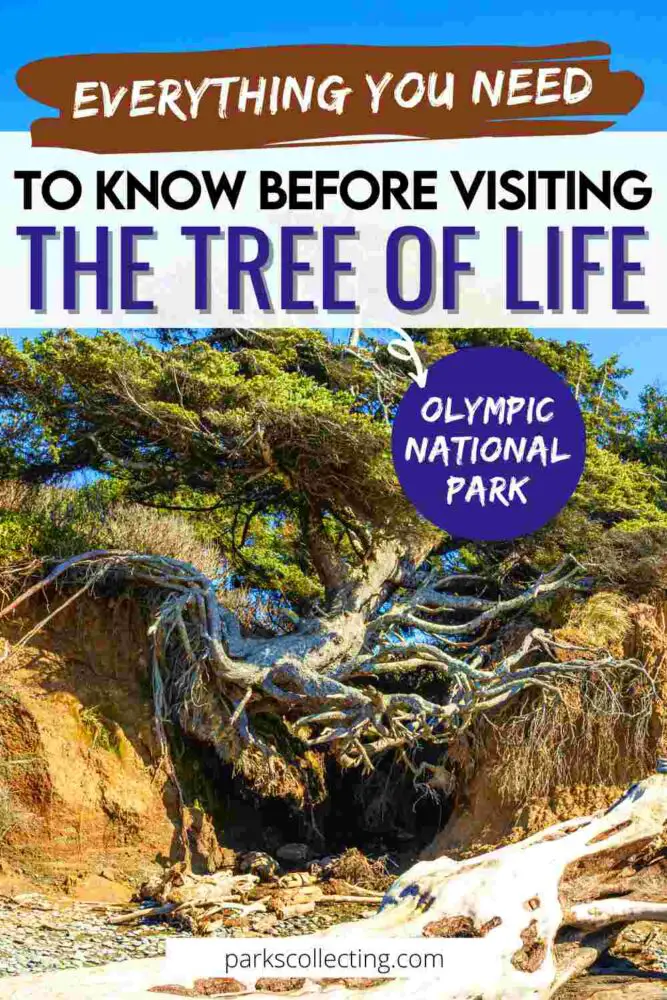
🛏️TOP HOTEL IN KALALOCH: Check availability now
🛏️TOP HOTEL IN PORT ANGELES: Check availability now
🛏️TOP HOTEL IN FORKS: Check availability now
🚘FIND THE CHEAPEST CAR RENTAL: Search Discover Cars for the best deals
✈️FIND THE CHEAPEST FLIGHTS: Search Skyscanner for the best deals
🧳GET TRAVEL INSURANCE: Get insured with Travelex before you go
📱TAKE AN AUDIO TOUR: Buy an audio tour now
Subscribe to daily national parks planning tips, travel inspiration and trip ideas and get instant access to the free PDF of this guide to
The Tree of Life
Table of Contents
What is the Olympic National Park Tree of Life
The Tree of Life is a Sitka spruce tree that is perched on the edge of a short sandy bluff on the edge of Kalaloch Beach.
A narrow stream travels down the bluff and over time, has eroded a channel directly beneath the tree. This has created a deep crevice – with the tree hanging above it. The tree now hangs in air, supported only be the very edges of its roots on either side. Which seems impossible.
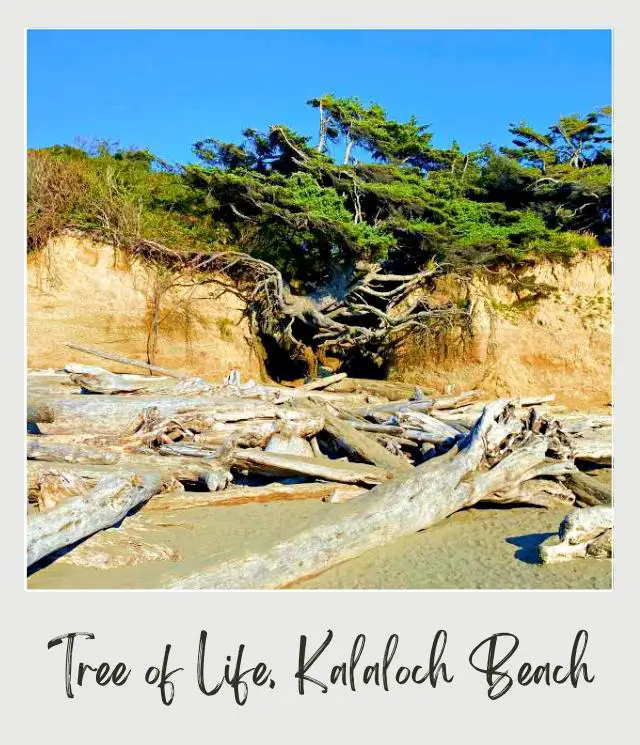
It looks like magic, but perhaps even more impressive is the demonstration of the power nature and this tree’s will to live.
Trees use their roots to get nutrients from the soil. So, this tree, with most of its roots exposed, shouldn’t be able to live. Yet live it does. The top is green and the tree appears healthy, though the erosion is ongoing and the tree has sunk in recent years.
The Pacific Northwest coastline is also famous for its strong winds and epic storms. The stairs down to the beach are washed away from time to time. Yet somehow this tree still clings to life.
Which is why is nickname The Tree of Life seems so appropriate.
Another thing that makes this tree even more amazing – it’s a Sitka spruce tree. These are the largest kind of spruce trees – the largest is 305 feet tall and 16.5 feet wide! So how does a tree type that is known for its size and height end up short, wide and clinging to life hanging over a gaping crevice supported by just a few root tendrils? Another of the mysteries behind this mystical tree.
Beneath the ‘floating’ tree, the roots have formed a cave with a ceiling of roots. The Kalaloch Tree Cave, as this is sometimes called, is big enough for a person to fit inside (though please don’t actually try to go inside – it’s dangerous and you risk damaging the tree). The stream flows into the cave, deepening the erosion each year.
Where is the Tree of Life located?
Where is the Tree of Life? Fortunately, the location of the Tree of Life is not one of its mysteries. It’s actually very easy to find and see.
The Tree of Life is located on Kalaloch Beach on the Olympic Peninsula and inside Olympic National Park, near Forks, Washington. It’s about 180 miles | 3 hours from Seattle.
Nearby are the Hoh Rainforest, Lake Quinault, and other Olympic National Park beaches.
To access Kalaloch Beach, drive to the Kalaloch Campground Day Use area, where there is a parking lot and nearby picnic area.
Although this area is inside Olympic National Park, you do not need to pay an entrance fee for this section and parking in the day use area is free. There is usually a ranger at the campground entrance station which is next to the day use area if you want to ask any questions.
The tree is reached by a short and easy hike to and along the beach.

Tree of Life Hike, Washington
From the Kalaloch Beach day use parking lot, look for a small sign indicating the path to the beach.
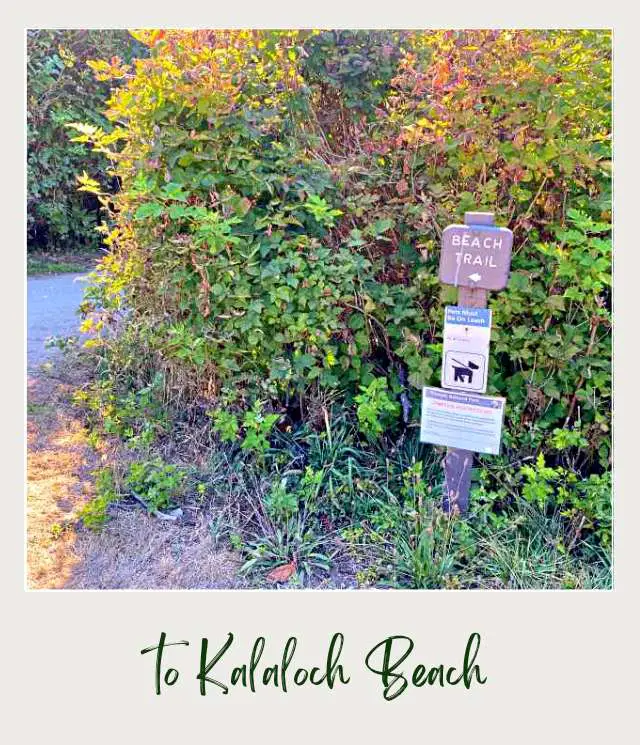
It’s only about a 3-minute walk in total from the parking lot to the Tree of Life. Kalaloch Beach is below a short bluff/ cliff, so there are about ten wooden stairs to navigate. Unfortunately, this means that it is not wheelchair accessible.
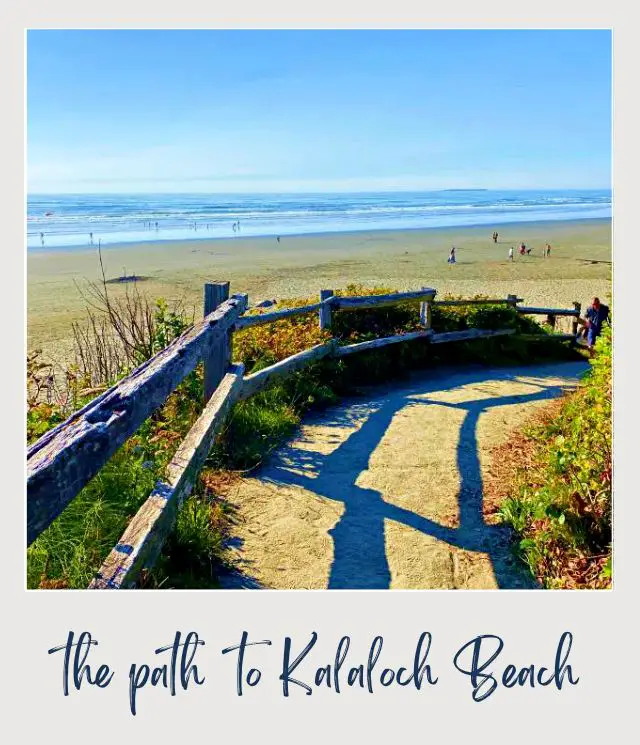
Sometimes these stairs are washed out after severe storms, but the NPS does a pretty good job of repairing them.
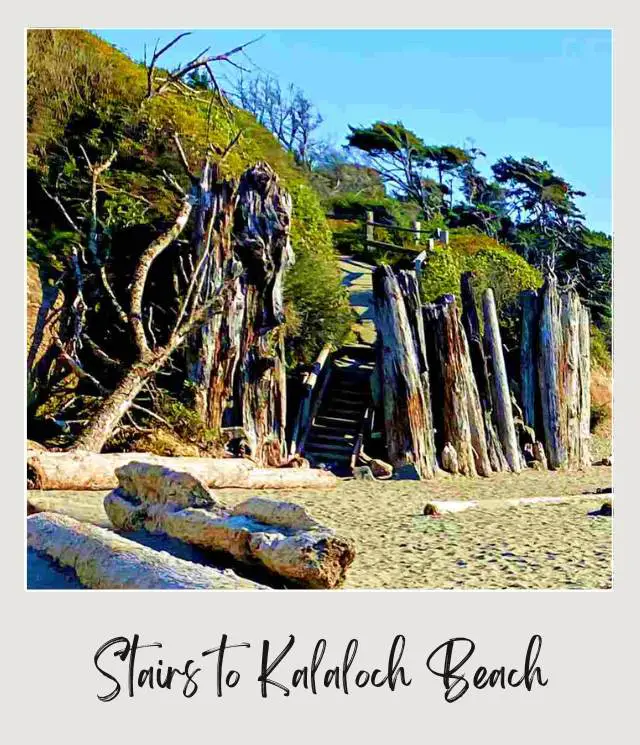
When you get to the beach, turn right. It’s a wide sandy beach that is a great place for families to hang out if the weather is nice.
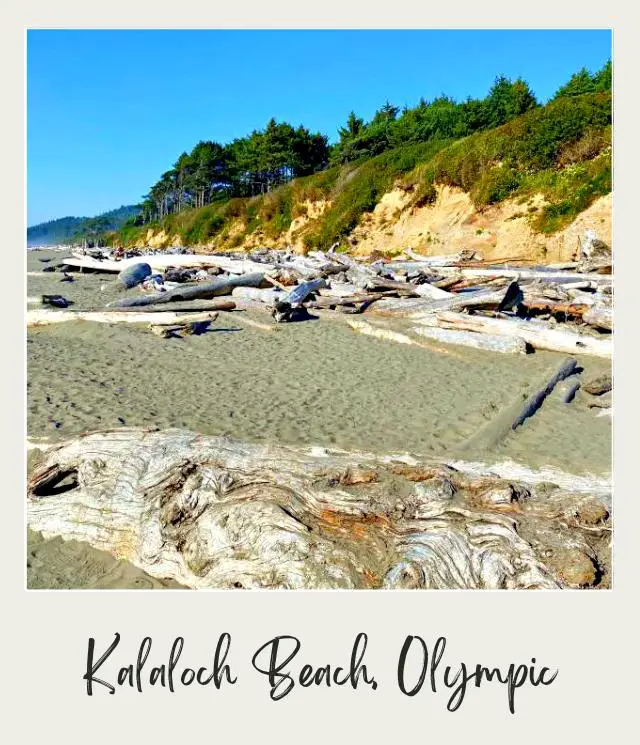
This being the Pacific Northwest and all, the weather is often not that pleasant, but definitely atmospheric. There is usually tree trunk-sized driftwood strewn over the beach near the cliff.
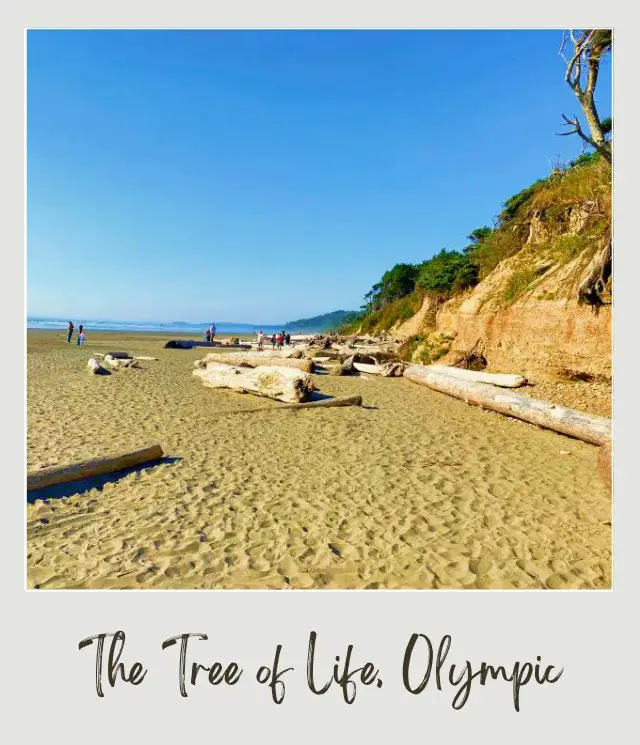
Walk along the beach for about 200 feet and you’ll see the Tree of Life, WA hovering in the air a few feet above the ground over a cut out in the cliff.
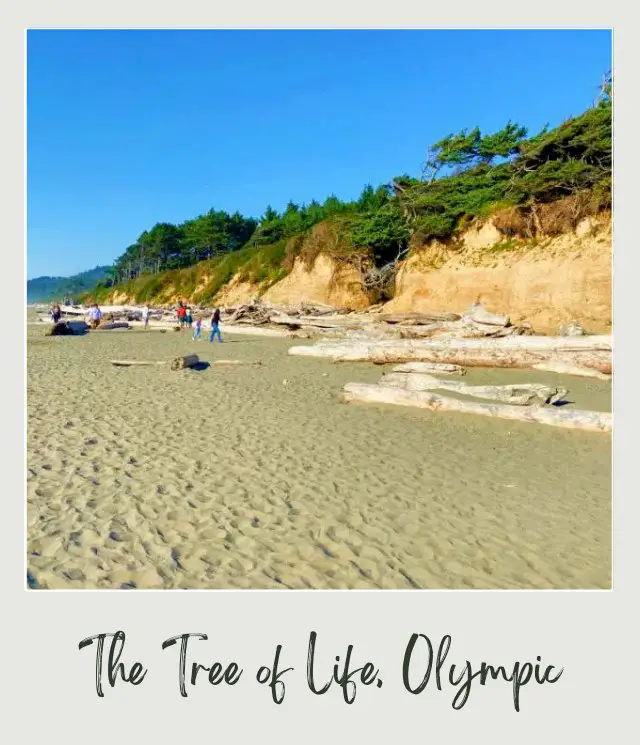
If you’re starting from Kalaloch Lodge head north along the path that skirts around the creek before arriving at the beach. Turn right and keep going north for about a half mile.
FAQS and Facts about the Tree of Life
How old is the Tree of Life?
No one knows for sure how old the Tree of Life is. Sitka spruce trees can live to be 800 years old. Staff at the nearby Kalaloch Lodge say that the tree has been an attraction since at least the 1950’s but the tree is probably much older than that.
One thing is more certain – it won’t live forever and could collapse at any time, so go see it now!
What kind of tree is the Tree of Life in Washington?
The Tree of Life is a Sitka spruce tree.
What does “Kalaloch” mean?
The beach is wide and flat, so it makes sense that “Kalaloch” comes from the Quinault word for “good place to land”.
Why is it called Tree of Life?
The tree clings to life despite seemingly impossible odds. With most of its roots suspended in air, how does the tree get enough nutrients to thrive? With just a few roots at each side supporting the entire tree, how does it stay afloat? With all the storms this area gets, and other trees frequently toppling, how come this tree doesn’t collapse?
A tree that fights all these odds to live is truly worthy of the name “Tree of Life”!
When to Visit the Tree of Life
The best time to visit Olympic National Park is in the summer and early fall (June through September). Temperatures are fairly mild and this is the dry season, so you’ve got the best chance of not being rained on (though it can rain at any time, of course).
However, July and August are by far the most crowded months, and if you visit at this time, get there early to get a parking space.
If you like foggy, rainy, windy weather, then winter is a good choice – and there won’t be many people there then.
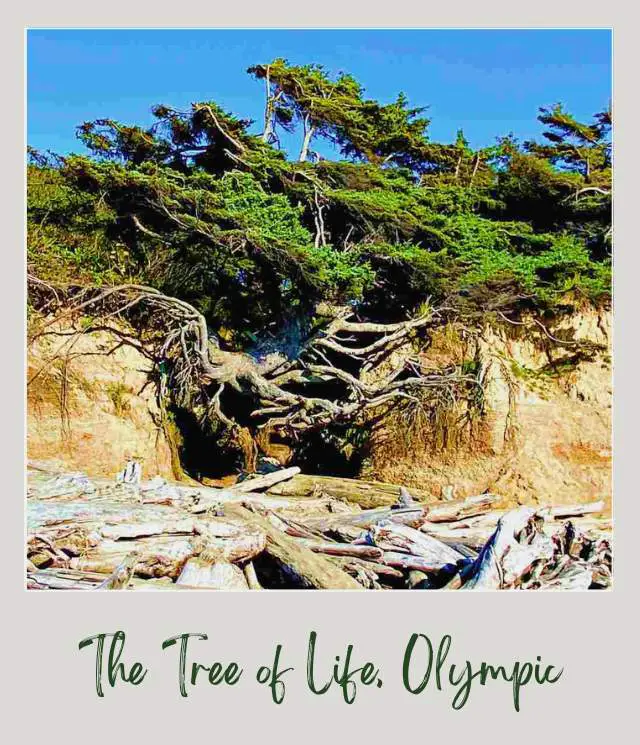
Where to Stay Near the Tree of Life
Camping
The Tree of Life is right next to Olympic National Park’s Kalaloch Campground. There are 170 sites, many with ocean views and it’s open year round. Most RV sites are for 21 feet, though they have a few for 35 feet. Online reservations are accepted up to 6 months in advance for the peak summer season. Check recreation.gov for specific dates. All campsites are first-come, first-served in the off-season.
Kalaloch Lodge
If you prefer not to camp, the nearest hotel is the Kalaloch Lodge. Tree of Life is just a half mile walk away. This is a classic old-style lodge with a variety of rooms including suites and cabins. They also have a nice creek-side restaurant, which makes a great place to relax before or after seeing the tree.

➡️ CHECK AVAILABILITY AT KALALOCH LODGE
Hotels in Nearby Forks
If you prefer to stay somewhere a little more central to other parts of Olympic National Park like the Hoh Rainforest, La Push Beaches, Sol Duc and Lake Crescent, then Forks is a god option.
Best Mid-Range Option
Woodland Inns
They have a variety of cabins with
- 2 Queens
- 1 King + 1 sofa bed
- 1 King + 1 sofa bed
- 1 King + 2 Twins + 1 sofa bed
- 1 King + 2 bunk beds + 1 sofa bed.
All cabins have a porch, private bathroom and private kitchen. Free WiFi, air conditioning, a flat screen TV and free parking are all included. This is an ideal option for couples or families.
➡️ CHECK AVAILABILITY AT WOODLAND HERE
Best Budget Option
Pacific Inn Motel
They have rooms with one or two Queen beds or a King-sized bed. Plus, a couple Twilight movie-themed double Queen rooms if you’re a fan! It has all the basic motel amenities like free WiFi and parking and a picnic area. The staff are friendly and the rooms are clean. Pets are not permitted.
➡️ CHECK AVAILABILITY AT PACIFIC IN MOTEL HERE
Tips for Visiting the Tree of Life
‼️To get the best view and see the tree in all its glory, it’s best to stand back a few hundred feet from the tree. Try to visit at low tide so you can get this more distant view. Check the official NOAA Tides Chart to decide the best time to visit.
‼️After seeing the tree from afar and appreciating how incredible it is that it’s still ‘floating’, it’s also interesting to see it up close, so you can see the cave created by the roots.
However, don’t go inside the cave or touch the tree at all. No one knows how long it will continue to stand, so it is dangerous to go beneath the roots – and we want the tree to be there as long as possible and disturbing it in any way might hasten its demise.
‼️Unfortunately, the tree could collapse at any moment. Before making the effort to see it, it’s worth checking that it is still standing/ floating. You can call Kalaloch Lodge 866-662-9928 or check to see if there are any recent TripAdvisor Reviews.
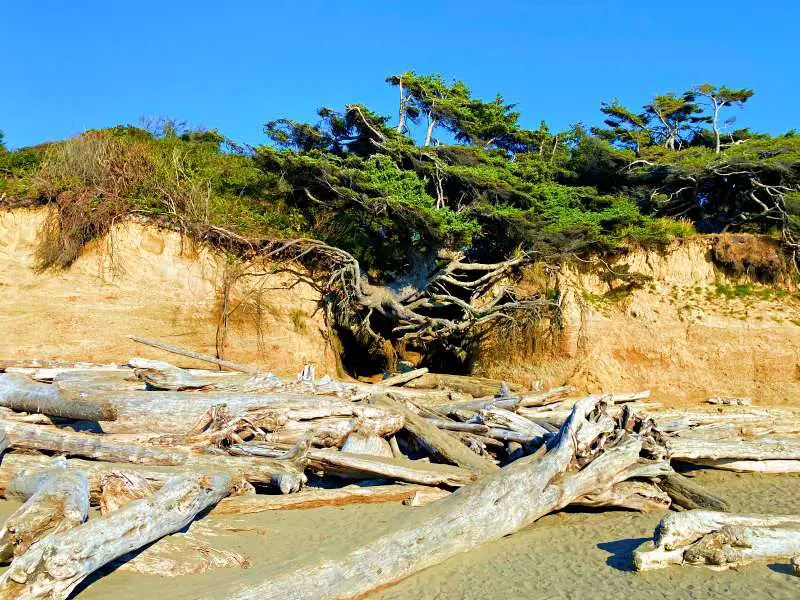
Travel Insurance for Olympic National Park
While the walk to the Tree of Life tree isn’t especially difficult, you should definitely get travel insurance for your trip. This can protect you against medical and emergency repatriation, as well as cover things like trip cancellation, loss and/ or theft of property, etc.
➡️ A great insurance option is Travelex. It has coverage for all you’ll need. You can choose the best travel insurance plan for your trip here or get a quote right now:
Enjoy the Olympic Peninsula Tree of Life!
More Planning Resources for Olympic National Park
⭐ Olympic National Park Guide
⭐ Olympic National Park Itinerary
⭐ 7 Mistakes to Avoid in Olympic
⭐ How Many Days in Olympic National Park?
⭐ Packing List for Olympic National Park
⭐ Best Things to Do in Olympic National Park
⭐ Best Views In Olympic National Park
⭐ Best Waterfalls in Olympic National Park
⭐ Best Hikes in Olympic National Park
⭐ Visiting Hurricane Ridge: Complete Guide
⭐ Best Hurricane Ridge Hikes
🔹 Hurricane Hill Trail Guide
🔹 Cirque Rim Trail Guide
🔹 High Ridge Trail to Sunrise Point Trail Guide
⭐ Best Hikes Near Lake Crescent
🔹 Marymere Falls Trail Guide
⭐ Best Sol Duc Hikes
🔹 Sol Duc Falls Trail Guide
🔹 Ancient Groves Nature Trail Guide
🔹 Sol Duc Salmon Cascades
⭐ Best Hoh Rainforest Hikes
🔹 Hall of Mosses Trail Guide
🔹 The Hoh River Trail Guide
⭐ Best Olympic National Park Beaches
⭐ Best Tide Pools in Olympic National Park
🔹 Rialto Beach Guide
🔹 Kalaloch Beach 4 Guide
🔹 Third Beach Guide
🔹 Second Beach Guide
⭐ Best Lake Quinault Hikes
🔹 Maple Glade & Kestner Homestead Trails
⭐ Lake Quinault Loop Drive: A Complete Guide
⭐ 12 Tips for Visiting Olympic National Park
⭐ How To Get to Olympic National Park
⭐ All The Airports Near Olympic National Park
⭐ The Closest Airport to Olympic National Park
⭐ The Best Time To Visit Olympic National Park
⭐ What To Expect Throughout the Year
⭐ 10 Fun Facts About Olympic National Park
What do think of the Tree of Life, Forks, Washington? Are you interested in seeing it? Did you see it? What does it look like now? I’d love to hear your thoughts. Join my private Facebook group National Parks Collectors and comment and let me know (you can also pick up extra planning tips, share your photos and stories with other national park lovers and more).
Subscribe to daily national parks planning tips, travel inspiration and trip ideas and get instant access to the free PDF of this guide to
The Tree of Life
If you liked this article about the Tree of Life, Olympic Peninsula, Pin It to your Olympic National Park board!


💡 Are you just starting to think about taking a national parks trip? Get Inspiration
‼️ Are you looking for helpful tips for visiting US national parks? Read articles that share useful tips on a range of national-park related issues
💻 Are you starting to plan a trip to Olympic National Park? Read my Guide to Olympic National Park
📋 Do you want a ready-made super detailed plan for your trip to Olympic? Get a detailed 1 – 4-day Olympic National Park Itinerary
💲 Are you ready to book your trip? Use these Planning and Booking Resources
📖 Do you want to read a book about US national parks? Check out my Recommended Reading Lists
About the Author
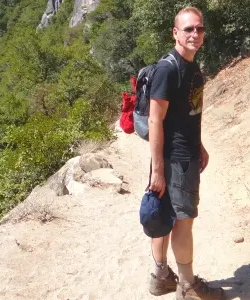
James Ian is a national park, camping and hiking expert.
He has dedicated his life to travel, visiting more than 80 countries, all 7 continents and most of the national parks in the United States. With over 35 years experience in the travel industry, James has worked on cruise ships, at resorts and hotels, and as a travel planner who’s helped hundreds of people plan successful trips to US national parks.
Based on his experience visiting our national parks multiple times, in-depth research and expertise as a travel planner, James has published detailed itineraries for many of the major national parks in the US. These itineraries, as well as in-depth park guides, and other resources will help you have your own incredible trip to US national parks without stress and hassle.
As a national park expert, James has contributed to many publications, including USA Today, Newsweek, Time Business News, Savoteur, Best Trip, and Wired.
I’m a member of the Amazon Services LLC Associates Program. As an Amazon Associate I earn from qualifying purchases.
